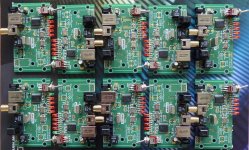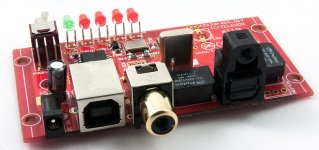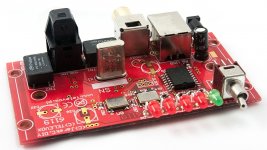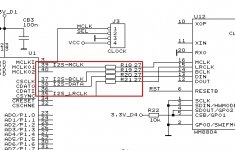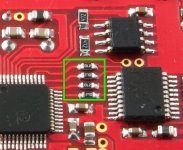Hi JarekC
Could you provide BNC connector vs RCA on the SPDIF version ?
If your answer is positive, does the circuit need to be adjusted for 75 Ohms ?
Another point concerning pic in Post #119, on the PCB there's a "Power" footprint, could you elaborate please ?
Regards
Phil
Could you provide BNC connector vs RCA on the SPDIF version ?
If your answer is positive, does the circuit need to be adjusted for 75 Ohms ?
Another point concerning pic in Post #119, on the PCB there's a "Power" footprint, could you elaborate please ?
Regards
Phil
Part of schematic and PCB with marked I2S bus.
You can remove resistor R18,R19,R20,R21 a then connect own DAC chip with I2S bus.
Or you can leave them and connect DAC to TAS1020B then DAC and WM8804 will be work parallel.
Best rergards,
JarekC
You can remove resistor R18,R19,R20,R21 a then connect own DAC chip with I2S bus.
Or you can leave them and connect DAC to TAS1020B then DAC and WM8804 will be work parallel.
Best rergards,
JarekC
Attachments
TAS1020 USB decoder source code
No sure whether any private party came up with open-source code.
Given the wide and cheap availability of Tenor, XMOS and SAVITECH chips, with their "hard-coded" drivers, not sure the old TAS1020 still matters. I think Ayre and Wavelength continues to use the chip tho' TI has discontinued it.
Do you on posting the source code? I'd be interested in looking at it.
AFAIK, only a few manufs. developed proprietary firmware to tweak the TAS1020 in its asynch. mode (for commercial application). Gordon Rankin (Wavelength, Ayre, and Pono (??)), Centrance and Bel Canto. There may be more.Hi,
The project was created for DIY (building DAC or extend the functionality of DAC).
At this moment PCB and kits are available on Polish DIY forum.
Published scheme allows independent modification of converter.
However, the source code is coryright and and will not be published.
No sure whether any private party came up with open-source code.
Given the wide and cheap availability of Tenor, XMOS and SAVITECH chips, with their "hard-coded" drivers, not sure the old TAS1020 still matters. I think Ayre and Wavelength continues to use the chip tho' TI has discontinued it.
I wrote the firmware myself.
I sterted this thread 4 yaers ago, since then a lot has changed
TAS1020B is still in production but it is not recommended for new design.
Ti don't have replacment for this chip.
If you don't need more than 96 kHz (for example old chips like TD1541A), it is a good chip.
Best regards
JarekC
I sterted this thread 4 yaers ago, since then a lot has changed
TAS1020B is still in production but it is not recommended for new design.
Ti don't have replacment for this chip.
If you don't need more than 96 kHz (for example old chips like TD1541A), it is a good chip.
Best regards
JarekC
Firmware
Seems as if firmware was big part of the trick in making this device work:
http://www.centrance.com/licensing/tas1020b.shtml
Too bad the Firmware Development Kit for TAS1020B is no longer around.
As I understand, then, you pre-programmed each of your sold converters using the TAS1020B's EEPROM? Or does the end user (customer) have to download/install a special firmware/driver file?I wrote the firmware myself.
Seems as if firmware was big part of the trick in making this device work:
http://www.centrance.com/licensing/tas1020b.shtml
Too bad the Firmware Development Kit for TAS1020B is no longer around.
As I understand, then, you pre-programmed each of your sold converters using the TAS1020B's EEPROM? Or does the end user (customer) have to download/install a special firmware/driver file?
Seems as if firmware was big part of the trick in making this device work:
http://www.centrance.com/licensing/tas1020b.shtml
Too bad the Firmware Development Kit for TAS1020B is no longer around.
Yes, I sent converters with pre-programmed EEPROMs.
I also have PC program (Win XP) for upgrading firmware by end user, but never was needed (users don't report any bugs).
When I started design, I was build my own development board.
I was relatively simple because TAS1020B can work with external control bus.
Regards
JarekC
Last edited:
TAS1020B USB
CEntrance, as noted earlier, was also licensing its own in-house firmware. I think the Rankin versions are better rated (??).
Correct me if I'm wrong: The TAS1020B also does asynchronous USB w/o any third-party firmware; i.e., via TI's factory firmware.
So how does a factory OEM and COTS TAS102B sound/perform in asynchronous mode (compared to third-party)?
From the Ayre white paper:
I think even as recently as a year or two back the "latest" Audioquest Dragonfly was using TAS1020B with Rankin's Streamlength (licensed) firmware.Yes, I sent converters with pre-programmed EEPROMs.
CEntrance, as noted earlier, was also licensing its own in-house firmware. I think the Rankin versions are better rated (??).
Correct me if I'm wrong: The TAS1020B also does asynchronous USB w/o any third-party firmware; i.e., via TI's factory firmware.
So how does a factory OEM and COTS TAS102B sound/perform in asynchronous mode (compared to third-party)?
From the Ayre white paper:
A “third-party” company has been certified by Texas Instruments to develop software for the TAS1020B. This company mainly works with manufacturers in the “pro” audio business, but also supplies their software solution to several audiophile-oriented companies. Their code allows high-resolution audio data (up to 96/24) to be transmitted across the USB port. While this approach offers the advantage of allowing the transfer of high-resolution audio data, it does little to address the jitter problem inherent in the PCM270x chips.
Their software averages the timing interval of four audio data packets instead of measuring each individual packet, but the master audio clock still changes frequency 250 times per second. And unlike the analog PLL used in the PCM270x parts that can continuously change the frequency of the master audio clock, the TAS1020B has a frequency synthesizer that can only change in discrete steps, exacerbating the jitter problem. However, as the D/A chip is now separated from the USB receiver, many audio companies use some sort of jitter reduction circuitry between the two, often in the form of an ASRC chip. But whatever approach is used, these circuits can only reduce jitter and not eliminate it.
[...]
Now the right ingredients existed to take advantage of the performance possibilities of the TAS1020B chip—a serious audiophile design engineer who also had extensive knowledge of computers and programming.
Gordon’s first approach was to use the expanded memory buffer of the TAS1020B to reduce the jitter while still using the “adaptive” USB transfer mode.
Recall that the previous “adaptive” solutions changed the frequency of the master audio clock at least 250 times per second. In contrast, Gordon wrote software code for the TAS1020B that allowed the chip to calculate the average data transfer rate of 250 audio packets, and then make minute corrections to a low-jitter, crystal-based external master audio clock only 4 times per second. The jitter was radically reduced and naturally the sonic benefits were commensurate. Wavelength began to establish a strong reputation for their line of USB D/A converter boxes.
Last edited:
I think even as recently as a year or two back the "latest" Audioquest Dragonfly was using TAS1020B with Rankin's Streamlength (licensed) firmware.
CEntrance, as noted earlier, was also licensing its own in-house firmware. I think the Rankin versions are better rated (??).
Correct me if I'm wrong: The TAS1020B also does asynchronous USB w/o any third-party firmware; i.e., via TI's factory firmware.
So how does a factory OEM and COTS TAS102B sound/perform in asynchronous mode (compared to third-party)?
TI oryginal firmware does not work in asynchronous mode.
TI never make such fimware.
I developed my own algorithm for switching clocks and use the FIFO no pops clicks etc.
TAS1020B has some undocumented bugs and features.
Some information can be found on TI's technical forum.
My discussion:
TAS1020B - Buffer size for ISO EP1 problem - Audio Converters Forum - Audio Converters - TI E2E Community
As I know engineers who designed TAS1020B no longer work in TI, they founded ther own company.
Best Regards
JarekC
Other (non-TI) USB decoders
Have you (anyone) tried replacing the original TAS1020B with a newer Tenor, SAVITECH, or XMOS. If so, how do they compare?
I assume Tenor, SAVITECH, etc. do provide asynchronous mode in their factory firmware (and that it is easy to use); hence, their popularity and TI phasing out its USB decoders.TI oryginal firmware does not work in asynchronous mode.
TI never make such fimware.
Have you (anyone) tried replacing the original TAS1020B with a newer Tenor, SAVITECH, or XMOS. If so, how do they compare?
Hi,
I think that now there is no perfect chip, each has some drawbacks.
XMOS:
Pros:
- low price
- driver avability
- avability in Digi-Key
Cons:
- power consumption
- I/O reclockd with 400MHz
- external USB PHY
- to modify firmware required experience in multi-threaded programming
C-MEDIA CM6631A
Pros:
- power consumption
- toolchain avability
- programming in standard C
Cons:
- mid price
- external parallel Flash for firmware
- not avialiable in Digi-Key, Mouser etc..
- no DSD (DSD only in CM6632A)
SaviAudio SA9227
Pros:
- power consumption
- DSD up to DSD256
- Serial EEPROM witjh configuration
Cons:
- price
- difficult to purchase
- hard coded firmware , EEPROM only with configuration
I have access for toolchains for all this chip (XMOS, C-MEDIA and SaviAudio).
I have plans to build new converter based on SaviAuio or C-Media.
But at this moment I work at another project (AK4137 ASRC):
http://www.diyaudio.com/forums/digi...-converter-ak4137eq-evaluation-board-diy.html
Best Regards
JarekC
I think that now there is no perfect chip, each has some drawbacks.
XMOS:
Pros:
- low price
- driver avability
- avability in Digi-Key
Cons:
- power consumption
- I/O reclockd with 400MHz
- external USB PHY
- to modify firmware required experience in multi-threaded programming
C-MEDIA CM6631A
Pros:
- power consumption
- toolchain avability
- programming in standard C
Cons:
- mid price
- external parallel Flash for firmware
- not avialiable in Digi-Key, Mouser etc..
- no DSD (DSD only in CM6632A)
SaviAudio SA9227
Pros:
- power consumption
- DSD up to DSD256
- Serial EEPROM witjh configuration
Cons:
- price
- difficult to purchase
- hard coded firmware , EEPROM only with configuration
I have access for toolchains for all this chip (XMOS, C-MEDIA and SaviAudio).
I have plans to build new converter based on SaviAuio or C-Media.
But at this moment I work at another project (AK4137 ASRC):
http://www.diyaudio.com/forums/digi...-converter-ak4137eq-evaluation-board-diy.html
Best Regards
JarekC
- Status
- This old topic is closed. If you want to reopen this topic, contact a moderator using the "Report Post" button.
- Home
- Source & Line
- Digital Source
- TAS1020B-based Asynchronous USB to I2S/SPDIF converter 24bit/96kHz
